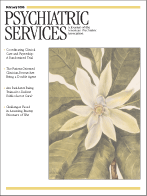European psychiatry enjoys a much richer phenomenologic tradition than its counterpart in North America. One might have expected the gap to have narrowed with the increasing emphasis on descriptive aspects of diagnosis since DSM-III was published in 1980. But modern American diagnostic practices focus on relatively superficial signs and symptoms rather than on an in-depth analysis of patients' experiences. Thus it is no surprise that the most interesting contemporary work on key psychiatric symptoms, such as delusions and hallucinations, comes from Europe, much of it from the United Kingdom.
Paranoia: The Psychology of Persecutory Delusions, a collection of previously published—and modestly revised—papers by Daniel Freeman and Philippa A. Garety, both psychologists at the Institute of Psychiatry in London, is representative of the best of this work. The authors' program of research has explored the origins and content of persecutory beliefs, the relationships between emotions and delusions, how delusional persons respond to disconfirmatory evidence and perceived threats, and the metacognitive processes that accompany delusional ideation. These studies have led them to a cognitive model of persecutory delusions that interestingly resembles the process proposed by Cameron almost 50 years ago.
Freeman and Garety understand persecutory beliefs as deriving from a person's search for the meaning of a set of unusual experiences. Why does one person respond to a series of chance encounters with a former acquaintance or a sequence of unusual somatic sensations with a paranoid explanation while another person shrugs off such events? The answer may lie in the paranoid person's reasoning style—which the authors have shown reflects a tendency to jump to conclusions on the basis of limited evidence—perhaps exacerbated by environmental pressures and a vulnerable emotional state. Once a paranoid explanation is identified, as Cameron first suggested, the person experiences relief from anxiety, as a result of "knowing" the cause of the anomalous experiences.
Delusions are maintained, despite the usual absence of directly confirmatory data—for example, the occurrence of the harm that is feared—by a tendency to downplay disconfirmatory evidence and focus on confirmatory data. Paranoid persons, for instance, may attribute their continued well-being in the face of malicious persecutions to the measures they have taken for self-protection—what the authors refer to as "safety behaviors." And their preoccupation with their delusional beliefs, with their attendant anxiety, heightens their search for apparent confirmatory evidence, some of which—such as the hostile responses of people whom they accuse of seeking to harm them—is generated by their own actions.
In contrast to the dominant North American model of delusions, delusional ideation as viewed by the leading British researchers exists on a continuum with normal thought. A more complete explication of this dimensional approach to psychopathology can be found in
Madness Explained: Psychosis and Human Nature, by another British psychologist, Richard P. Bentall (
1). Moreover, British researchers have taken the lead in applying cognitive therapeutic approaches to delusions and other psychotic symptoms, with provocative results. Thus it is no accident that Aaron Beck, the father of cognitive therapy, wrote the introduction to this monograph.
Given the limitations of medications for the treatment of many psychotic symptoms, it seems likely that the growing use of cognitive therapy to treat delusions and other psychotic phenomena will also spread on this side of the Atlantic. The clear and precise phenomenologic description of the cognitive processes associated with delusions embodied in this volume and related work forms the basis for these cognitive interventions. It is by no means too early for clinicians in North America to become familiar with this work, and Paranoia: The Psychology of Persecutory Delusions is a fine place to begin.

